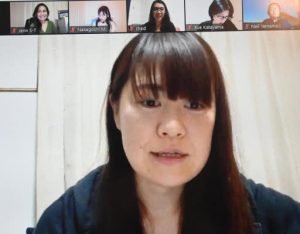Hiroshima Peace Volunteers introduce Peace Park memorial monuments online to U.S. elementary school students in new initiative amid coronavirus pandemic
May 31, 2021
by Miho Kuwajima, Staff Writer
At the end of May, several Hiroshima Peace Volunteers, whose work involves providing explanations about exhibits in the Hiroshima Peace Memorial Museum in the city's Naka Ward, introduced A-bomb monuments in Hiroshima Peace Memorial Park using an online format to elementary school students in the United States. The volunteers cooperated in the project as a new initiative amid the halt to their usual activities due to the coronavirus pandemic.
About 90 fifth-graders at three schools in the eastern U.S. state of New Jersey, along with their parents, joined the online tour. Showing a previously filmed video online using a screen-sharing system, about ten Hiroshima Peace Volunteers explained in English that many boys and girls fell victim to the atomic bombing as well as the background behind the construction of the Children's Peace Monument, among other topics.
At the start of the online tour, Hiroko Watanabe, 36, a resident of Hiroshima’s Asaminami Ward, mentioned how the area in and around Hiroshima Peace Memorial Park was once a bustling business district. She asked the students, “What are you always doing at 8:15 (a.m.)?” She added, “Eight fifteen in the morning was the time the bomb was dropped. The bomb fell on an ordinary day.” After the one-hour online tour of the Peace Park monuments, children asked such questions as “Do you still celebrate Peace Day?” and “How many different countries are represented by the cranes?”
The Hiroshima Peace Volunteers received the request for the online project as part of a lecture series held by the private-sector organization Real Innovative Connections, located in Hawaii, through which participants learn about the history of the Pacific theater of World War II. Jennifer Sagon-Taeza, founder/executive director of the organization and organizer of the project, reflected on the online tour and said, “I was extremely impressed with the presentations.” She added, “I felt the passion and dedication of preserving and sharing the history of Hiroshima in all of the presentations.” Ms. Watanabe also expressed her enthusiasm. “I think the project served as an opportunity for children in the United States to learn about Hiroshima. Although we have been unable to perform our usual activities for a year, I hope to continue, in this way, planting the seeds of peace,” she said.
(Originally published on May 31, 2021)
At the end of May, several Hiroshima Peace Volunteers, whose work involves providing explanations about exhibits in the Hiroshima Peace Memorial Museum in the city's Naka Ward, introduced A-bomb monuments in Hiroshima Peace Memorial Park using an online format to elementary school students in the United States. The volunteers cooperated in the project as a new initiative amid the halt to their usual activities due to the coronavirus pandemic.
About 90 fifth-graders at three schools in the eastern U.S. state of New Jersey, along with their parents, joined the online tour. Showing a previously filmed video online using a screen-sharing system, about ten Hiroshima Peace Volunteers explained in English that many boys and girls fell victim to the atomic bombing as well as the background behind the construction of the Children's Peace Monument, among other topics.
At the start of the online tour, Hiroko Watanabe, 36, a resident of Hiroshima’s Asaminami Ward, mentioned how the area in and around Hiroshima Peace Memorial Park was once a bustling business district. She asked the students, “What are you always doing at 8:15 (a.m.)?” She added, “Eight fifteen in the morning was the time the bomb was dropped. The bomb fell on an ordinary day.” After the one-hour online tour of the Peace Park monuments, children asked such questions as “Do you still celebrate Peace Day?” and “How many different countries are represented by the cranes?”
The Hiroshima Peace Volunteers received the request for the online project as part of a lecture series held by the private-sector organization Real Innovative Connections, located in Hawaii, through which participants learn about the history of the Pacific theater of World War II. Jennifer Sagon-Taeza, founder/executive director of the organization and organizer of the project, reflected on the online tour and said, “I was extremely impressed with the presentations.” She added, “I felt the passion and dedication of preserving and sharing the history of Hiroshima in all of the presentations.” Ms. Watanabe also expressed her enthusiasm. “I think the project served as an opportunity for children in the United States to learn about Hiroshima. Although we have been unable to perform our usual activities for a year, I hope to continue, in this way, planting the seeds of peace,” she said.
(Originally published on May 31, 2021)








